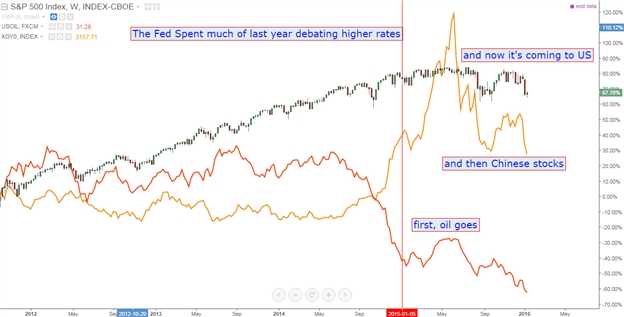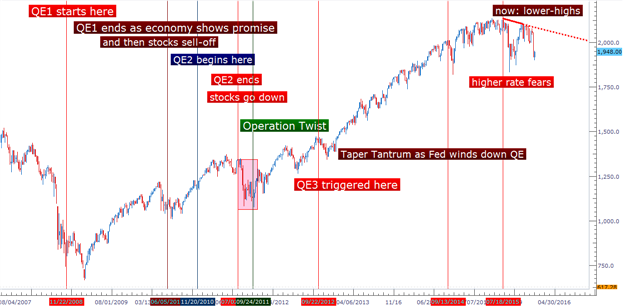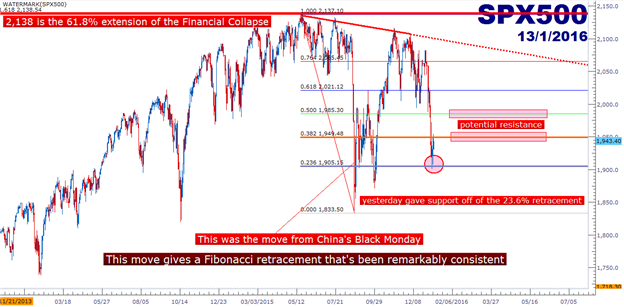Talking Points:
- Chinese stocks saw even more pressure last night with an aggressive downward move towards the close, but the rest of the world is seeing a sense of stability after an aggressive start to the year.
- This sense of stability on the morning has many asking ‘have we hit a bottom.’ Don’t ever ask that question – it screams of naiveté because the answer, even if you did know, is irrelevant to your goals.
- Trading isn’t just guessing; it’s more about probabilities; price action + sound risk management, especially in volatile markets. If you’re looking for directional ques, check out our real-time SSI.
It’s been a pretty active start to 2016 for markets, hasn’t it? Not a single day has gone by in which there hasn’t been a profound set of risks starting traders directly in the face. And oddly, it started right with the new year as Chinese equities began putting in brutal moves even before desk traders arrived for work on their first day back from holiday.
With so many risk factors in the air, it’s certainly plausible to understand how this all started. We had even penned a set of articles to close out last year in this same market talk article series to discuss the three ‘biggest’ themes pertinent to these risks. We started out by identifying the risk of an Asian Slowdown continuing to spread throughout the global economy. Well, that’s really heated up already and we’re still in the first two weeks of 2016. So this will likely continue to develop.
In part 2, we looked at the threat of continued carnage in commodity prices, and how this will, eventually, bring massive impact to economies with oil exposure. The unfortunate part: The United States falls in this camp, so as producers in the largest economy in the world continue to see their margins get squeezed by falling oil prices, we’re likely going to see collateral damage. The banks that loaned to these outfits, well they’re probably not going to be paid back entirely. Just yesterday, the Wall Street Journal ran a headline piece on the potential for rising bankruptcies on the back of this theme. And if banks get hit – there is little chance of that pain not spreading further. Banks aren’t stupid, if they’re taking losses, they’ll tighten up risk, just as any smart trader will do. And this means lending will dry up, and then the Fed is directly wedged between a rock and a hard place as they’re trying to raise rates (tighten the money supply), while banks would be in a position to tighten the money supply even more (by slowing lending activities). So, something will have to give there, or else we’re facing a really troubling scenario. And this led directly into part 3, which is probably the most pressing concern for the rest of the world right now:
Rates. In part three of that series, we looked at what is probably the most pressing concern although it appears to be getting far less press than the earlier two themes. And this is likely because headlines sell, and rates aren’t a really attractive lead for media outlets. Most people don’t understand interest rates, so it’s much easier to just point the finger at China or Commodities and blame them for all of the world’s problems. But that would be intellectually disingenuous because this entire mess started last year as the Fed continued to talk up higher rates while the rest of the world was showing pressure.

Created with Tradingview; produced by James Stanley
In June, Chinese equities began their descent lower and Oil began to break down from resistance at the $60-handle. Yesterday we hit below $30 in Oil, so we’ve shed half of this commodity’s value in around seven months. Just imagine if you were an oil producer? How much pain would you be feeling right now – as current prices would likely be below break-even, and that’s before debt service comes into the question.
And while all of this was developing, the Fed continued to talk up higher rates. Perhaps more disconcerting is their outlook for the future. This year, the Fed is expecting four rate hikes this year while markets are only pricing in two. This is a clear sign of the Fed losing confidence from markets, as markets are pricing in their own rate hike schedule without regards to the Federal Reserve’s own projections. To be sure, some element of divergence here isn’t out of the norm; but to see such bifurcation would be, historically speaking, notable.
Forward guidance was rolled out in 2008 in response to the Financial Crisis. This was at the same time that rates were jacked down to near-zero in an effort to stem the bleeding. Everyone was scared: Everyone. So a bunch of stuff was thrown against the wall by the Fed in the hope that it would work. TARP (Troubled Asset Relief Program – this is when banks became ‘Too Big to Fail’) and the initial round of QE came from this. The thought behind forward guidance was that if the Fed was totally open with markets about their desire to keep rates super-low for super-long, maybe that would entice investors to jump back in to markets and take on risk?
At first, the world was curious. After all, we just saw stocks get hammered by 50%+ in stocks the United States and things around the world weren’t much better; but eventually this super-accommodative stance from the Fed helped to turn things around, and investors started to take on risk again.
The only problem was that many of the structural deficiencies that led to the collapse in the first place remained unaddressed. Many of these are political, and will likely remain unchanged until something breaks. This is just the way that politics works, unfortunately; ‘electability’ matters. We simply picked up where we had left off, and a few years later stocks were trading at new all-time highs.
Each stumble that we had thereafter took place as the Fed threatened to turn off the liquidity cannons, first in 2010 and then again in 2011; and the Fed responded to those ‘corrections’ with more loose monetary policy hints. After that hit in 2011, the Fed really turned up the volume by triggering Operation Twist and later in September 2012 a 3rd round of QE, so the printing presses were working overtime with both of these programs in place.
A Market Propelled by Stimulus: The S&P 500 on QE. It hasn’t done well without it.

Created with Marketscope/Trading Station II; prepared by James Stanley
This is why all of those short calls since 2008 have been so misplaced: Getting short stocks over the past six years has been diametrically opposite of the Fed. You don’t fight the Fed in this business, or any large Central Bank for that matter.
And that’s what makes this the year that prices may finally begin to tumble.
Ms. Yellen dropped a hint in early December that she feared a higher probability of a recession if the Fed didn’t raise rates. This was a huge clue. This is the head of the world’s largest Central Bank telling you that she’s afraid of a bubble, or even worse, a series of bubbles that could potentially pop each other. She didn’t use the ‘b’ word, and that’s important – because just the simple utterance of that word by a Central Banker could spark a panic that could take on a life of its own.
But this is what it is: Six years of ZIRP encouraged, or even prodded investors to take on risk. The Fed engineered this, that’s what the second and third rounds of QE were, as well as Operation Twist. The world wasn’t melting down at the time. Risks were very real, but the United States needed fiscal stimulus. We needed politicians to step up to the plate and fix the problems that led to the Financial Collapse in the first place. This didn’t happen.
The Fed was making the environment super-accommodative in the effort of triggering growth. Stock prices went up. But not much else ‘recovered’ other than asset prices. But this was to be expected, right? Monetary stimulus isn’t designed to fix fiscal problems.
To put this in a real-world scenario: this is like a person that spends $10k a month when they only make $3k. So this person is living way beyond their means, and their burn rate is unsustainable. How much long-term help will it be to that person to take out a credit card to pay this month’s bills? Sure – it’ll get them to next month, but now they have to pay interest. More credit is only exacerbating the problem. The fiscal issue of this person’s cash flow is not being solved.
This is where the world is at right now: We’ve been living on credit cards for far too long, and this is why Ms. Yellen was so insistent on kicking rates higher. Further – this is probably why the Fed is sticking to this whole ‘four rate hikes’ in 2016 theme: They don’t want to build a massive bubble that the world cannot recover from.
But forward guidance is no longer accommodative, is it? What was previously looked at as an easy and cheap form of stimulus (telegraphing to markets that you will keep rates super-low for super-long) has now become just another factor of downward pressure on the entire global economy. With so much ‘stuff’ thrown against the wall by Central Banks in 2008 to combat the Financial Collapse, we don’t know what ‘works’ and what doesn’t. It’s pretty obvious that this whole forward guidance idea is too much transparency for markets in a non-emergency situation, because we’re fighting a rate hike 11 months from now when we should instead be focusing on how to improve today. The world moved along just fine pre-2008 without forward guidance, and it’s likely that it could do so again. Markets aren’t supposed to fear the Fed’s actions a year from now, because there is a high probability that the environment will be different a year from now, and will require a different response than what we think might be necessary a full year before we get there.
The reason for telling you all of this in a trading article is to highlight what an utter mess the United States is right now, both politically and economically. And these feed into each other because economics allows politics to exist, but politics, unfortunately, regulates economics around the world.
For now – the S&P is catching its breath after a huge open to the year. The daily chart is showing bullish tendencies, so this isn’t the area in which you want to get short, at least not yet. Let it continue to run higher until resistance comes into play, and then look to trigger when you can get an attractive risk-reward ratio.
We likely haven’t seen the end of this theme. The Fed wants rates higher, nay – the Fed needs rates to move higher. These multiple rounds of stimulus have only served to distort the ‘real’ economy around the world, exacerbating income inequality and all sorts of other bad, long-term sociological issues.
But to the trader – this presents the prospect of continued volatility: So while the world goes through some very real and very troubling ‘growing pains’ or ‘withdrawal symptoms’ or whatever else you want to call it – manage your risk. Volatility is coming, that much is sure. We’re in the midst of seeing history be made as neo-Keynesian economics faces its most difficult and complicated tests ever. And we’re in an election year in a United States that is massively divided and politically coagulated. The chart below shows the current setup in the S&P 500.

Created with Marketscope/Trading Station II; prepared by James Stanley
--- Written by James Stanley, Analyst for DailyFX.com
To receive James Stanley’s analysis directly via email, please SIGN UP HERE
Contact and follow James on Twitter: @JStanleyFX






